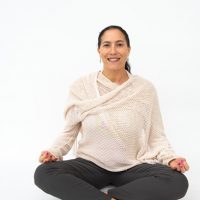
Eating animal flesh is not a part of the yogic tradition, yet many claim to teach yoga while eating animals.
While some like to debate about the legitimacy of this topic, I prefer to focus on the animals that are suffering and educating others so that I can try to help reduce that suffering.
The reality is that “over 56 billion farmed animals are killed every year by humans. These shocking figures do not even include fish and other sea creatures whose deaths are so great they are only measured in tonnes.” (Animal Equality) This is an unfathomable amount of suffering and violence done to living beings, daily, and we all have a choice to support or oppose it.
Ahimsa is the Sanskrit term for “non-violence,” the basis of yogic living, according to the Yoga Sutras of Patanjali. Yogic philosophy believes in non-harming, which is why yogis are typically vegetarian.
According to the Yoga Sutras, the very first sutra is Yama, the observances, which includes ahimsa. Yoga Sutra II.35 says, in Sanskrit, “ahimsa-pratishthayam tat-sannidhau vaira-tyagah,” which translates to, “When you stop harming others, others will cease to harm you.”
The third limb of yoga is asana, or yoga posture, and it is typically the focus of the practice at most modern yoga studios and health clubs. However, as yoga master Dharma Mitra reminds us, “Yoga without the Yamas is like spaghetti without the sauce.” More seriously, he has said that “one must extend one’s compassion beyond one’s pets,” and that “when one eats animals one is engaging in cruelty.”
Similarly, Mahatma Gandhi (may or may not have) said, “The most violent weapon on earth is the table fork.”
Millions of yoga practitioners and teachers are putting their body in shapes resembling animals, such as fish pose (matsyasaana), cow pose (gomuhkasana), and the like. I wonder if they are reflecting on the violence they support by eating them as well?
One way to expand our compassion to include animals is to think of the animals we are mimicking. Then, we can ponder how we can take part in easing the suffering that humans inflict on them daily. For example, in Fish Pose we can think of the fish who were once swimming free in their home, stolen from the ocean and then killed for someone’s dinner.
I also think of the destruction of the Earth it causes. For example, they predict that by 2048, if commercial fishing is continued at its current pace, the world’s oceans will be depleted of fish. Not to mention the dolphins, sharks, turtles, and other ocean life that are killed in the large nets as a side effect of the fishing industry.
The work of the yogi can include helping to reduce this suffering.
We often chant Lokah Somasta Sukhino Bhavantu (“may all beings be happy and free”) at the end of each yoga class. After chanting for the freedom of all beings, the least we can do is ensure that our next meal isn’t an animal or baby animal that was held captive and murdered.
How can we live the practices off the yoga mat? Making nonviolent, compassionate choices each meal is one way.
I feel blessed to have been raised vegetarian, thanks to the gurus who taught my parents about vegetarian eating before I was born. They ate no meat, poultry, or fish, so I have never tried and have never considered dead animals a food.
More recently, though, I also learned the harm done to animals in the dairy industry, including killing innocent chicks and baby cows who can’t produce eggs or milk. I visited the Animal Place Rescue Farm in California and saw for myself the small veal crates that so cruelly hold baby cows captive for a few weeks, where they cannot even turn around, let alone nurse on their mother, and then are slaughtered for food—all because the male baby cows don’t produce milk, which is profit for the dairy industry.
Is the pleasure of our palate worth the suffering and life of another living creature?
When I learned that the dairy industry is tied to the meat industry, I realized I was still supporting and ingesting violence by eating eggs, cheese, and drinking cow’s milk. Many yoga ashrams now have vegan options, as even the yogic diet is shifting with the times to be more sustainable and adhere to ahimsa.
I have heard many of the reasons other yoga teachers and students eat meat. However, in my understanding, experience, and belief there is no need to get nutrients from a dead animal, as long as access to vegan options is available. I am personally not concerned why people choose to go vegan, whether for sustainability, health, or ethical reasons—I am only concerned that the animals don’t suffer and die needlessly.
According to the Factory Farm Awareness Coalition, 99 percent of animal products come from factory farms. They also say that “even in cage-free operations, most chickens see sunlight for the first time when taken to slaughter.”
There is no way to deny the violence in consuming animals.
Yoga Master Sivananda said, “People who are slaves to the flesh-eating habit cannot give up animal diet, because they have become confirmed and inveterate meat-eaters, and hence they try to justify their habit by various arguments and statistics. One cannot change their ways merely by argumentation and disputation. Ultimately, it is only the force of personal example that has a strong effect upon the people around you.”
I hope to see yoga teachers encouraging students to take their compassion off the yoga mat, and onto their plates, for the sake of the animals, the Earth, and all beings.
Author: Stacie Dooreck
Image: Author’s Own; @ecofolks
Editor: Emily Bartran
Copy Editor: Nicole Cameron
Social Editor: Catherine Monkman








Read 1 comment and reply